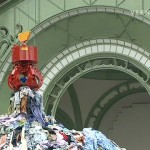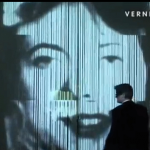The French Pavilion at the 54th International Art Exhibition – La Biennale di Venezia, curated by Jean-Hubert Martin, presents a new installation by French artist Christian Boltanski. The installation, titled “Chance”, deals with the themes that are characteristic for Boltanski’s work: chance, luck and misfortune.
In the main room Christian Boltanski installed a large scaffold with a oversize film strip that shows the faces of babies shortly after their birth. The film strip runs at high speed until it randomly stops and picks one of these babies, displayed on an lcd screen. In each of the two side rooms, a large digital clock counts up the world’s population.
Christian Boltanski: Chance / French Pavilion, Venice Biennale 2011. Preview, June 2, 2011.
See also: Christian Boltanski: Personnes / Monumenta 2010 at Grand Palais Paris / Interview and Christian Boltanski. La vie possible / Kunstmuseum Liechtenstein.
> Right-click (Mac: ctrl-click) this link to download Quicktime video file.
Press Release:
The theme of the French Pavilion
At the recent Monumenta exhibition called Personnes, an exhibition that was later installed and exposed at The Park Avenue Armory in New York and the Hangar Bicocca in Milan, Christian Boltanski demonstrated his ability to deal with universal themes, while at the same time ensuring that everyone is free to interpret his work in their own way. The artist has again chosen “Chance” as his theme for Venice. In a mobile and unstable environment, this theme is developed in a more playful and interactive way by allowing the public to play and to win with the artist.
Resolutely independent of particular movements and schools of thought, Christian Boltanski deals with existential questions on a spectacular level, merging fact and fiction, in an artform that he himself refers to as classical, not in terms of its form but in terms of the themes it deals with, such as “Chance, Godʼs Law and Death”. Reflecting on the passage of time, Chance is one of the links in the chain of memory, in what can be referred to as “little” or “individual” memory, that which defines the fragile uniqueness of each person, and which form part of the immense collective work The Archives of the Heart (Les Archives du CÅ“ur). Since 2005, Christian Boltanski has been collecting recordings of heartbeats from all over the world, in order to attempt the impossible: to collect “the heartbeat of everyone in the world”. A truly universal project, the recordings will be preserved on the Japanese island of Teshima on the Seto Inland Sea, thanks to the support of a sponsor and is open to the public. In this spirit of allegorical and utopian works, Christian Boltanski “sold his life” (i.e. a continuous video recording of his work and activities in his studio) to a collector in Tasmania. This lifetime annuity was granted in an attempt to create yet another permanent installation, in what the artist refers to as “his deal with the devil”.
The work presented at Venice is optimistic in its reflection on chance and destiny; the chance of birth against the chance of death. Is everything pre-determined? Who controls destiny? Has our path already been decided? Is God present or absent? At the entrance to the pavilion, the visitor is invited to sit on one of the wooden chairs. A voice whispers to him. Each chair “speaks” in a different language uttering the words “Is this the last time?” Is this a message of hope? Or a troubling announcement?… The interior of the pavilion is criss-crossed by a moving walkway, that travels at great speed and upon which hundreds of photos of childrenʼs faces have been printed. The walkway stops randomly and one of the childrenʼs faces is lit up and an alarm sounds. Chance has picked out one child. The process begins all over again, until the walkway stops again and the alarm signals Chanceʼs next choice.
In each of the two side rooms, a clock with luminous numbers counts up the worldʼs population. The panel on the left records, in real-time, the number of births and the panel on the right, the number of deaths. Every evening at midnight, they provide the figures of the day. The number of births is always higher than the number of deaths! Every day witnesses the victory of life over death. In the third room, there is a large mural work consisting of a huge video screen on which various images of different segments of human faces are projected. By pressing on a button, the visitor can pause the images. The faces are made up of three random sections creating strange even monstrous faces, the fruit of a wild imagination. If the visitor is lucky, the three sections of the face match and he wins the image shown.
Throughout the duration of the Biennale, a version of this work will be available on www.boltanski-chance.com. Lucky winners will receive a surprise sent personally by the artist.Christian Boltanski
Born in Paris in 1944, Christian Boltanski practices painting until the end of the 1960s. The artist plays with autobiographical codes and recreates objects and situations from his childhood. From 1970 to 1973, he creates Reference Display Cases (Vitrines de references) by subverting museographic codes: made or found objects are exhibited as evidence of a banal life of which only some traces, at times even absurd ones, remain. In 1972, The Album of Family D. (Lʼalbum de la famille D.) is presented at Documenta in Kassel and launches the artistʼs international career. After Comic Sketches (Saynètes comiques / 1974), where the artist reveals himself in scenes from his childhood in a clown-like manner, he returns to a distant and impersonal viewpoint in Model Images (Images modèles) which he creates according to the guidelines of “accepted” or “classical” photography. He is one of the principal founders of “art photography” and his work on “average taste” anticipates developments in post-conceptual art. From 1984 with series such as Shadows (Ombres), Monuments (Monuments), Reliquaries (Reliquaires) and Reserves (Réserves), his work takes on a darker tone. The materials from his early works are re-used in dramatic installations that are haunted by the idea of death. The questioning of existence becomes a prominent theme in his work, as illustrated by the work presented at Documenta 8 in Kassel in 1987. In 1988, clothing becomes a key material in the artistʼs work; a ghostly mark of the individual. Cataloguing and filing, and later an obsession with lists, characterize the artistʼs work from the 1990s, reminding us that within a group or a mass, the individual is what is important. From 1990 to 2000, Christian Boltanski becomes interested in performance, which extends and enriches his fine art work. At the same time, his exhibitions become more narrative and staged, creating a global work based around a single theme: Time, Memory, the Human Being, Death… He now favours projects with a humanistic content that fall within the register of the fable.
In this spirit of allegorical and utopian works, Christian Boltanski has been collecting recordings of heartbeats from all around the world since 2005 as part of his project destined for the Japanese island of Teshima, entitled The Archives of the Heart (Les Archives du cœur). In Tasmania, another permanent utopian installation was recently created: the artist sold his life in an annuity to a collector (video recording of his work and activities in his studio). In 2010, the unique visual and sound installation Monumenta / Personnes was created especially for the Grand Palais in Paris. In this work, the artist continues his reflection on the limits of humanity and the importance of memory, on destiny and the inevitability of death. Personnes was later installed at The Park Avenue Armory in New York and in the Hangar Bicocca in Milan.
Jean-Hubert Martin
Jean-Martin Hubert has played a key role in some of the worldʼs most important museums. He has worked as director of the Bern Kunsthalle, the Centre Pompidou National Modern Art Museum and The National Museum of African and Oceanic Arts. He was the director of the Museum Kunst Palast in Dusseldorf before deciding to devote himself to the conception and curatorship of exhibitions. From the famous Magicians of the Earth (Magiciens de la terre) in 1989 which played an important role in altering perceptions of 20th century art to the successful Against Exclusion (Contre lʼexclusion) as part of the 2009 Moscow Biennale, Jean- Hubert Martin has continued to occupy a key position in the international art scene. He has regularly exhibited Christian Boltanski in his exhibitions, for example, in The Magicians of the Earth and the more recent Breaking News (Ultime Notizie) in Milan in 2004.
Les Opérateurs du Pavillon français
LʼInstitut français assure le commissariat général du Pavillon français de la Biennale de Venise en co-production avec le Centre national des arts plastiques (CNAP) et en collaboration avec la Direction générale de la création artistique (ministère de la Culture et de la Communication) et avec le mécénat exclusif de Citroën. Ce projet fait lʼobjet dʼune Commande publique du ministère de la Culture et de la Communication et, í ce titre lʼœuvre présentée rejoindra les collections du Centre national des arts plastiques.
L’Institut français est lʼagence du ministère des Affaires étrangères et européennes pour lʼaction culturelle extérieure de la France. LʼInstitut français Å“uvre en faveur des arts visuels et de l’architecture, tant en direction des artistes et créateurs vivant et travaillant en France que sur le continent africain et dans la région caribéenne. Il est lʼopérateur du Pavillon français de la Biennale de Venise et coproducteur de certaines grandes Biennales, notamment en Afrique. Il accompagne des étapes internationales dʼexpositions dans le cadre de la diffusion des collections publiques ou dans celui de la programmation des musées ou partenaires étrangers, il soutient la présence dʼartistes français dans les foires internationales et favorise le repérage des scènes artistiques par les professionnels étrangers. www.institutfrancais.com
Le Centre national des arts plastiques (CNAP) est lʼun des principaux opérateurs de la politique du ministère de la Culture et de la Communication dans le domaine des arts visuels. Acteur culturel et économique, il encourage la scène artistique dans toute sa diversité et accompagne les artistes ainsi que les professionnels par plusieurs dispositifs dʼaides et dʼallocations. Il acquiert, pour le compte de lʼEtat, des Å“uvres dʼart inscrites sur les inventaires du fonds national dʼart contemporain, donc il assure la garde, la gestion et la diffusion en France et í lʼétranger. Il met en Å“uvre la commande publique nationale et favorise lʼaccès de tous les publics í lʼart contemporain. www.cnap.fr
La Direction générale de la création artistique (ministère de la Culture et de la Communication) définit, coordonne et évalue la politique de lʼÉtat relative aux arts du spectacle vivant et aux arts plastiques et détermine les conditions de sa mise en Å“uvre. Elle soutient la création artistique dans tous ses domaines dʼexpression, favorise la diffusion des Å“uvres et lʼaccès du plus grand nombre aux productions artistiques. Parmi ses missions, elle a reçu celle de coordonner des manifestations dʼampleur nationale et internationale vouées í la valorisation de la scène artistique française. Cʼest dans ce cadre que sʼinscrit, aux cí´tés de grandes manifestations nationales comme MONUMENTA et LA TRIENNALE, le soutien quʼelle apporte í la mise en Å“uvre du Pavillon français.
Mécène exclusif du Pavillon français í la Biennale de Venise, CITROí‹N occupe une place í part dans la création automobile. Née en 1919 au pied de la Tour Eiffel, la marque n’a jamais dévié de son héritage : l’audace et le sens de l’innovation. Elle a marqué l’histoire avec des modèles surprenants: la Traction Avant, la 2CV, la DS. Des modèles devenus mythiques, créés par un sculpteur, Flaminio Bertoni. Avec la DS, í laquelle Roland Barthes a consacré un passage de son essai Mythologies, CITROí‹N a reçu en 1957 le prix d’honneur í la Triennale de Milan. Un mythe qu’elle fait aujourd’hui revivre avec le lancement de sa ligne distinctive DS. Nourrie par l’expression artistique, sous toutes ses formes, CITROí‹N est une source d’inspiration pour les créateurs : la Traction avant, traction après (1990) d’Arman, la DS (1993) de Gabriel Orozco, ou les Compressions de Citroën réalisées par César pour la Biennale de Venise 1995. En avril 2011, le designer Ora-í¯to présentera í Milan ses projets artistiques, inspirés eux aussi par l’héritage CITROí‹N. Symbolisée par la signature CRÉATIVE TECHNOLOGIE, l’ambition de CITROí‹N est bien de repousser les limites de l’expérience automobile.







